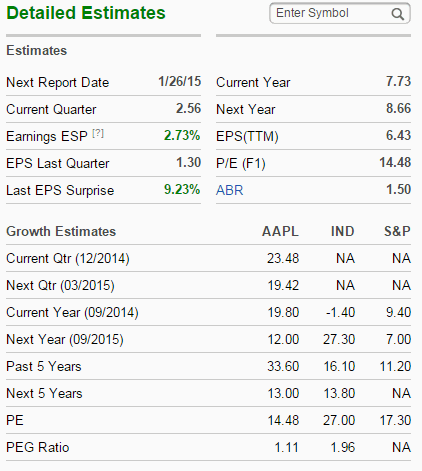Computerized Investing
Post on: 12 Апрель, 2015 No Comment

by CI Staff
Valuation metrics are quantitative valuations of companies that can be used to estimate the valuation of a security against its peers. In previous installments of Computerized Investings Fundamental Focus, we discussed the ubiquitous price-earnings ratio and, similarly, the price-earnings relative (these can be accessed online here ). The price-earnings ratio is only one of several useful valuation metrics used to analyze stocks. In this installment of Fundamental Focus, we present several other valuation metrics in detail.
The PEG Ratio: Price-Earnings to Growth
The price-earnings ratio (PE) is easy to understand and simple to calculate: It is merely price divided by earnings. It fails to directly take into account an imperative characteristic (we hope) of any stockgrowth. It is, however, a measure of the markets opinion of the companys future prospects, including growth. From a pure price-earnings valuation standpoint, a stock that is trading at a price-earnings ratio of 10 is trading at a discount relative to a stock trading with a price-earnings ratio of 15. However, investing in the lower PE stock may not be a prudent choice if the higher PE stock is growing twice as fast. When evaluating firms that are growing at significantly different rates, it is more practical to employ the PEG ratio to take into account growth rates. The PEG ratio looks at earnings growth relative to the price-earnings ratio and is calculated as follows:
PEG = PE earnings growth
Several versions of the PEG ratio can be calculated; the most popular is trailing PEG (trailing 12-month PE divided by historical earnings growth rate) and forward PEG (forward PE divided by estimated long-term earnings growth). Using data from Stock Investor Pro (with estimated earnings growth rates from I/B/E/S), the following numbers were pulled for Exxon Mobil Corp. (XOM). trailing 12-month PE of 9.4, forward PE of 9.4, historical five-year earnings growth rate of 4.9% and estimated long-term earnings growth rate of 9.2%. Using these numbers, PEG ratios for the stock are calculated as follows:
XOM Trailing PEG = 9.4 4.9 = 1.9
XOM Forward PEG = 9.4 9.2 = 1.0
As a comparison, we also pulled the numbers for Chevron Corp. ( CVX) and calculated the PEG ratios as follows:
CVX Trailing PEG = 7.1 11.5 = 0.6
CVX Forward PEG = 7.2 5.1 = 1.4
At first glance, Exxons trailing and forward price-earnings ratios of 9.4 may seem to indicate that it is trading at a premium compared to Chevrons price-earnings ratios of 7.1 and 7.2, respectively. Further examining the stocks by incorporating growth through the PEG ratios, Exxon is trading at a forward PEG of 1.0 while Chevron is trading at a forward PEG of 1.4. This tells us that based on estimated growth rates, Exxon is trading at a discount relative to Chevron.
When using analyst estimates, it is important not to take them at face value. Be sure to examine the estimated growth rates and decide for yourself whether they are too optimistic or pessimistic. Exxons estimated growth rate is 9.2% going forward, after growing at 4.9% annually for the last five years. Chevrons historical growth rate is 11.5% and estimated growth rate is 5.1%. Be sure to consider for yourself whether it is reasonable to expect a significant increase in growth from Exxon and a simultaneous decrease in growth from Chevron.
Price-to-Book Ratio
There are certain cases where price-earnings ratios are meaningless. For instance, a company with negative earnings will have a negative price-earnings ratio. In this case, a different valuation metric should be used to evaluate stocks. The price-to-book ratio (PB) works well for companies with a lot of hard assets, such as manufacturing firms.
The price-to-book ratio gives investors a quick look at how the market is valuing the assets of a firm. As the name implies, the ratio can be calculated as follows:
PB = price book value per share
Book value is the net assets of a company less any intangible assets. Once again, we use Stock Investor Pro to pull the book value for the same two firmsExxon Mobil Corp. (XOM) and Chevron Corp. (CVX). For the most recent quarter, XOM has a book value of $30.30 per share while CVX has a book value of $63.91 per share. Using the price at the market close on May 25, 2012, the price-to-book ratio is computed as follows:
XOM PB = $82.08 $30.30 = 2.7
CVX PB = $98.86 $63.91 = 1.5
Using this metric, we see that Chevron is trading at a discount relative to its book value when compared to Exxon Mobil.
Once again, this metric has its limitations. Namely, it does not take into account intangible assets, which can be significant especially for firms with considerable intellectual property. Furthermore, this metric should be used for similar companies in the same industry and across several time periods.
Price-to-Sales Ratio
Another commonly used valuation metric is the price-to-sales ratio (PS). The metric gained prominence in the early 2000s and again recently with the rise of technology and Internet firms that have yet to generate significant trends in earnings. The belief is that with strong sales and sales growth, compared to the current price, earnings should follow at some point in the future. In addition, sales are harder to manipulate than earnings.
The formula for the price-to-sales ratio can be calculated in one of two ways:
PS = price sales per share, or
PS = price average shares outstanding sales
To accurately calculate the ratio, you must use average shares outstanding to either find the market capitalization of the firm (by multiplying current price by average shares outstanding), or find the sales per share (by dividing sales by average shares outstanding). Stock Investor Pro is used to first calculate the sales per share for Exxon Mobil and Chevron.
Sales per share = sales average shares outstanding
XOM sales per share
= $496,478 million 4,715 million
= $105.29 per share
CVX sales per share
= $254,070 million 1,964 million
= $129.36 per share
Using these figures, the two firms PS ratios are calculated as follows:
XOM PS = $82.08 $105.29 = 0.78

CVX PS = $98.86 $129.36 = 0.76
As you can see, using the price-to-sales ratio suggests that the two firms are actually very similarly valued. This illustrates that it is wise to use several valuation metrics when evaluating comparable companies.
Price-to-Cash-Flow Ratio
Earnings are the most commonly used valuation metric when comparing against price. However, due to complicated accounting rules and regulations, different firms may have different ways of recognizing revenues and reporting earnings. Net income, or earnings, is reported under the principles of accrual accounting, which attempts to match expenses to revenues. Management decisions on asset write-offs, depreciation and reserves against losses can all affect the bottom line. Hence, many analysts look at an underlying metric that leaves little room for management discretioncash.
The price-to-cash-flow ratio (PCF) provides investors with a valuation that the market is placing on a firm when compared to its cash flow. The PCF is calculated as follows:
PCF = price cash flow per share
Cash flow per share can be found on a companys cash flow statements. It can also be calculated by adding together cash from operations, cash from investing and cash from financing, taking into account exchange rate effects.
Again using AAIIs Stock Investor Pro for the underlying data, the current cash flow per share for XOM is $1.25 and for CVX is $2.88. Using these figures, the price-to-cash-flow ratios are calculated as follows:
XOM PCF = $82.08 $1.25 = 65.7
CVX PCF = $98.86 $2.88 = 34.3
Using this ratio alone, it would appear that Exxon is trading at a significant premium relative to Chevron. However, cash flow takes into account cash to and from outside sources, such as outward cash flows from repaying loans or investing in other firms or cash inflows from borrowing funds. Investors may find it beneficial to look at a variation on the PCFthe ratio of price to free cash flow.
Price-to-Free-Cash-Flow Ratio
The price-to-free-cash-flow ratio (PFCF) is a modified free cash flow ratio. The formula is as follows:
PFCF = price free cash flow per share
Free cash flow is calculated by subtracting capital expenditures and dividends paid from cash flow from operations. This modified cash flow shows the cash that a company has left over to expand, develop new products, buy back stock or pay down its debt. It is worth mentioning that many sources calculate free cash flow by simply subtracting capital expenditures from cash flow from operations. At AAII, our belief is that once a company declares dividends, it does not typically suspend the dividend unless the health of the firm is in jeopardy. Therefore, the cash flow paid out as dividends is no longer free. Using Stock Investor Pro, the PFCFs for XOM and CVX are calculated as follows:
XOM PFCF = $82.08 $3.54 = 23.2
CVX PFCF = $98.86 $2.82 = 35.1
Using the price-to-free-cash-flow ratio, the opposite seems to be true with Chevron trading at a premium relative to Exxon.














